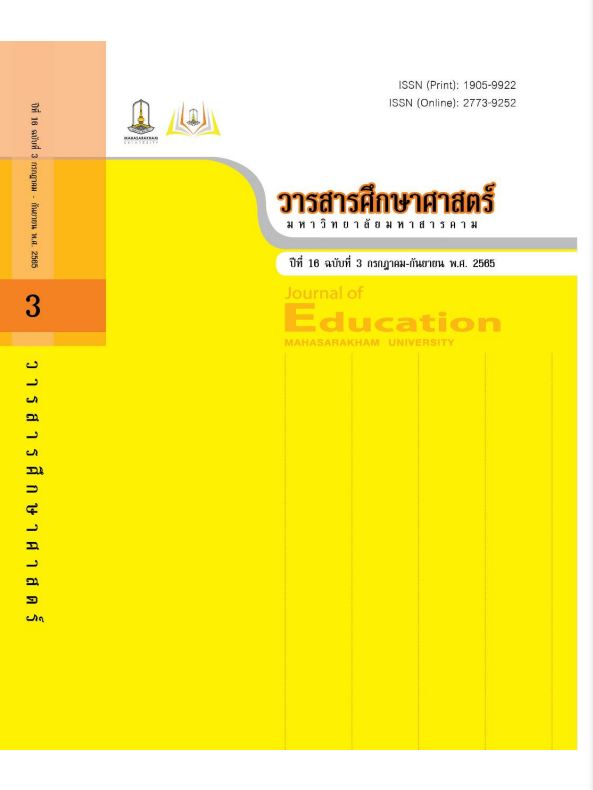STEM to STEAM: Teaching Innovation in Art Education
Main Article Content
Abstract
STEM education is an issue that many countries are interested in. It has set goals for educational management to develop human resources with knowledge and skills in the field. STEM education, for example, England, Australia, Singapore, Japan, Korea. An example of a country with a strong focus on STEM and STEM education is the United States. By designating the STEM as the core of the educational standards announced at the national level. with the promulgation of educational standards STEAM Education Definition of STEM and main characteristics of STEM learning activities The US federal policy requires that each state to implement a framework that covers the entire system. From defining a comprehensive definition of STEM, defining careers in STEM-related fields, conducting research and development, to entering the STEM workforce into the professional sector. It is a learning management approach by integrating Science, Technology, Engineering, Arts, and Mathematics. together by focusing on the learners to create a body of knowledge and be able to apply the knowledge gained until they develop skills in solving immediate problems and being able to create new things, new innovations whether it is a thought process, concept, and way of life. There are three important factors in learning management, namely the presentation of the situation, creative design, and emotional touch through learning and creating works in various formats that promote learners with skills, competencies, and integration of learning. to daily life Expanding knowledge with innovations for development and meet the changing needs of the 21st century.
Downloads
Article Details

This work is licensed under a Creative Commons Attribution-NonCommercial-NoDerivatives 4.0 International License.
References
ธีรวัฒน์ ประกอบผล. (2564). ผู้เชี่ยวชาญทางด้านการจัดการเรียนรู้แนว STEAM Education. สัมภาษณ์. 2 พฤษภาคม 2564.
นันทวัน จันทร์กลิ่น. (2557). ปญหาและแนวทางการบริหารจัดการคุณภาพในการพัฒนาประถมศึกษาพิษณุโลกเขต 2. วิทยานิพนธ์ครุศาสตรมหาบัณฑิต. มหาวิทยาลัยราชภัฏพิบูลสงคราม.
วิสูตร โพธิ์เงิน. (2561). STEAM ศิลปะเพื่อสะเต็มศึกษา. การพัฒนาการรับรู้ความสามารถและแรงบันดาลใจให้เด็ก, 1(45), 320-334.
วรพจน์ วงศ์กิจรุ่งเรือง และอธิป จิตฤกษ์. (2556). ทักษะแห่งอนาคตใหม่: การศึกษาเพื่อศตวรรษที่ 21. กรุงเทพฯ: โอเพ่นเวิลด์ส.
สิราวรรณ จรัสรวีวัฒน์. (2560). การจัดการเรียนรู้แบบบูรณาการในยุคประเทศไทย 4.0 ตามแนวคิด STEM, STEAM, และ STREAM. วารสารการศึกษาและพัฒนาสังคม, 13(1), 19-30.
สำนักงานบริหารและพัฒนาองค์ความรู้ (องค์การมหาชน). (2561). STEM Education หนึ่งในเครื่องมือปฏิรูปการเรียนรู้ของไทย, The Knowledge, 2(9), 3-5.
Fioriello. (2010). Understanding the basics of STEM education. Retrieved September 15, 2018. from http://drpfconsults.com/understanding-the-basics-ofstem-education.
Taylor, P.C. (2018). Enriching STEM with the arts to better prepare 21st century citizens.
STEM to STEAM. (2016). What is STEAM?. Retrieved from http://stemtosteam.org/
Yakman, G. (2008). STEAM education: an overview of creating a model of integrative education. Retrieved September 22, 2021, from https://www.academia.edu/8113795/STEAM_Education_an_overview_of_creating_a_model_of_integrative_education.
Yakman, G. (2011). STEM education: an overview of creative of integrative education. Retrieved Nov 17, 2021. From http://steamedu.com/

